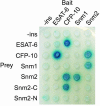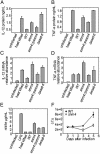Acute infection and macrophage subversion by Mycobacterium tuberculosis require a specialized secretion system
- PMID: 14557536
- PMCID: PMC240734
- DOI: 10.1073/pnas.2235593100
Acute infection and macrophage subversion by Mycobacterium tuberculosis require a specialized secretion system
Abstract
Although many bacterial pathogens use specialized secretion systems for virulence, no such systems have been described for Mycobacterium tuberculosis, a major pathogen of humans that proliferates in host macrophages. In a screen to identify genes required for virulence of M. tuberculosis, we have discovered three components and two substrates of the first Sec-independent secretion pathway described in M. tuberculosis, which we designate the Snm pathway. Here we demonstrate that the proteins Snm1, -2, and -4 are required for the secretion of ESAT-6 and CFP-10, small proteins previously identified as major T cell antigens. Snm2, a member of the AAA ATPase family, interacts with substrates and with Snm1, another AAA ATPase. We show that M. tuberculosis mutants lacking either the Snm system or these substrates exhibit defects in bacterial growth during the acute phase of a mouse infection and are attenuated for virulence. Strikingly, snm mutants fail to replicate in cultured macrophages and to inhibit macrophage inflammatory responses, two well established activities of wild-type M. tuberculosis bacilli. Thus, the Snm secretion pathway works to subvert normal macrophage responses and is a major determinant of M. tuberculosis virulence.
Figures





References
-
- Dye, C., Scheele, S., Dolin, P., Pathania, V. & Raviglione, M. C. (1999) J. Am. Med. Assoc. 282 677-686. - PubMed
-
- McKinney, J. D., Jacobs, J., W. R. & Bloom, B. R. (1998) in Emerging Infections, eds. Fauci, A. & Krause, R. (Academic, London), pp. 51-146.
-
- Beltan, E., Horgen, L. & Rastogi, N. (2000) Microb. Pathog. 28 313-318. - PubMed
-
- Falcone, V., Bassey, E. B., Toniolo, A., Conaldi, P. G. & Collins, F. M. (1994) FEMS Immunol. Med. Microbiol. 8 225-232. - PubMed
-
- Giacomini, E., Iona, E., Ferroni, L., Miettinen, M., Fattorini, L., Orefici, G., Julkunen, I. & Coccia, E. M. (2001) J. Immunol. 166 7033-7041. - PubMed
Publication types
MeSH terms
Substances
Grants and funding
LinkOut - more resources
Full Text Sources
Other Literature Sources
Medical
Molecular Biology Databases
Miscellaneous

